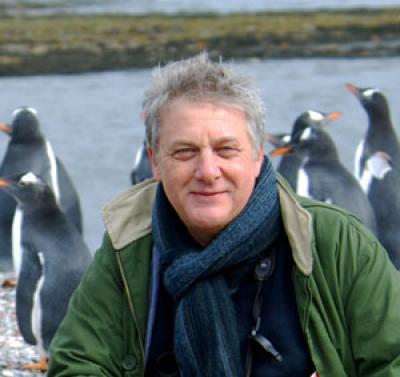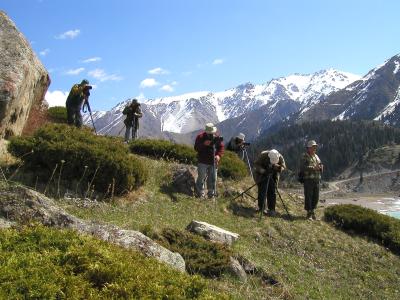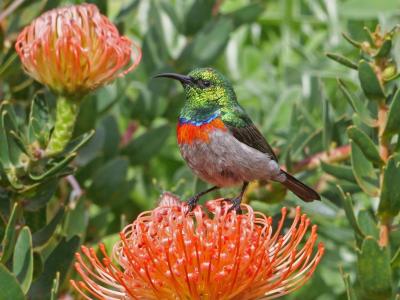Sri Lanka
-
Feb 9-24, 2026
Deepal Warakagoda and Steve Rooke
-
Feb 8-23, 2027
Deepal Warakagoda
2026
Single Room Supplement $1,020
2027
Tour Price to be Determined
2026
Single Room Supplement $1,020
2027
Tour Price to be Determined
Early travelers romantically named Sri Lanka ‘the teardrop of India.’ Just 270 miles long and 140 miles wide, this small island does indeed look like a tear that has fallen from the face of the subcontinent to become petrified in the Indian Ocean. Having, in reality, risen from the sea millions of years ago and subsequently subjected to much geological upheaval, Sri Lanka has developed into a magical land of mountains, gently undulating hills, open plains, and lush valleys. Running through these are countless rivers dotted with beautiful waterfalls, many hidden beneath a dense cloak of rainforest. For the birdwatcher, islands have the added attraction of endemic species that have evolved during centuries of isolation. Sri Lanka is no exception with upward of 34 unique birds, and we’ll endeavor to see them all. In addition, a large number of northern migrants winter on the island, joining many other resident species that are difficult or impossible to see on the usual birdwatching circuits of India. We should add that Sri Lanka has a rich cultural history that will surround us while we bird, and a famously hospitable people.
Day 1: The tour begins this afternoon at our hotel in Colombo, where we’ll have a short walk around the grounds before dinner in search of our first Sri Lankan birds. Night in Colombo.
Day 2: After breakfast we’ll drive to Sigiriya, a 600-foot-high, wide pinnacle of rock rising out of the jungle and perhaps the most striking sight on Sri Lanka. After checking in to our hotel, we’ll have time to explore the surrounding forest for our first birds, which could include Ceylon Grey Hornbill and a selection of woodpeckers such as the striking crimson form of Black-rumped Flameback and White-naped Woodpecker. Night in Sigiriya.
Day 3: Around the base of the imposing rock is an extensive series of ancient ruins, most of which have been swallowed by the jungle which will provide many of today’s birds. We’ll wander the extensive network of tracks and roadways in search of Oriental Scops, Brown Fish, and Forest Eagle Owls, Jerdon’s Nightjar, Blue-faced Malkoha, Black Drongo and Banded Bay Cuckoos, Oriental Dwarf Kingfisher, Indian Pitta, Ceylon Woodshrike, Large and Black-headed Cuckooshrikes, Blue-winged Leafbird, Orange-headed Thrush, Indian Black and Indian Blue Robins, Jungle, Ashy, and Grey-breasted Prinias, Green and Large-billed Leaf Warblers, and Brown-capped Babbler. This is also a great place to see, and hear, White-rumped Shama, perhaps the most beautiful song of any bird on the subcontinent. Night in Sigiriya.
Day 4: We’ll travel to Kandy, home of traditional Sri Lankan culture. For birds we need venture no further than the secluded grounds of our accommodation, an utterly delightful small hotel on the outskirts of the town with grounds that are visited by a range of species, and we’ll spend the afternoon in this peaceful setting. Night in Kandy.
Days 5–6: We’ll continue our drive into the highlands and the town of Nuwara Eliya which appears to have been lifted straight out of the English Lake District. Here we are in the heart of Sri Lanka’s hill country and tea-growing region, and we’ll make a stop to sample some of the tea for which the island is so famous. In the formal shrubbery and flower beds of Victoria Park we should see Indian Pitta and the striking Pied Thrush, while higher up on the Horton Plains we’ll search for Jerdon’s Baza, Yellow-eared Bulbul, Ceylon Scimitar-babbler, Sri Lanka Bush Warbler, and Sri Lanka White-eye, among others. Over the next few days we’ll visit many sites to look for Kashmir and Dull Blue Flycatchers, but the real prize of our visit to this region will be the elusive Arrenga, or Ceylon Whistling-thrush, one of the rarest and most magical birds on the island. Nights in Nuwara Eliya.
Day 7: Leaving the cool hill county, we’ll drive south into the dry lowlands and the village of Tissa, famous for its large tank (or lake) and ancient huge domed dagoba (Buddhist shrine). On the way we’ll stop at a reservoir to look for a variety of waterbirds including both Black and Yellow Bitterns. This afternoon we’ll visit Yala National Park, where we’ll encounter drier forest and open grasslands. These habitats are still very rich in birds, and we’ll look for Lesser Adjutant, Asian Openbill, Spot-billed Pelican, Great Thick-knee, and Ashy-crowned Sparrow Lark, among others. Yala is also home to many mammals, including Indian Elephant, Leopard, Sloth Bear, Wild Boar, Tufted Grey Langur, Sambar, and Spotted Deer. We’ll also venture out at dusk to search for Jerdon’s Nightjar and the more common Indian Nightjar. Night in Tissa.
Day 8: We’ll visit Bundla National Park, an extensive area of marsh and coastal lagoons, to look for Watercock, Ruddy-breasted Crake, a variety of waders including Pacific Golden Plover and Pintail Snipe, and hordes of stunning Blue-tailed Bee-eaters. In the evening we’ll explore the ancient reservoirs in the Tissa area to see more waterbirds, especially Watercock and any species of bittern missed during our previous birding sessions. Night in Tissa.
Day 9: Leaving Tissa we’ll drive to Udawalawe National Park and we should reach our hotel in time for lunch and spend the afternoon visiting the Park. Established to protect the forest catchment of a large reservoir, this park is home to good numbers of waterbirds and mammals. We’ll switch to open-topped jeeps and drive around the park searching for the distinctive Sri Lankan forms of Crested Hawk-eagle and Barred Buttonquail, as well as Lesser Adjutant, Malabar Pied Hornbill, Plum-headed Parakeet, Orange-breasted Green Pigeon, Sirkeer Malkoha, Jungle Prinia, Forest Wagtail, and Blyth’s Pipit. We can also expect close encounters with some of the many wild Indian Elephants that inhabit the park. Night in Udawalawe.
Day 10: Before breakfast we’ll visit a birding site looking for Coppersmith Barbet, Yellow-crowned Woodpecker, Jerdon’s Leafbird, Small Minivet, Ashy-crowned Sparrowlark, Oriental Skylark, and Yellow Wagtail. Later we’ll journey west into the wet zone and our comfortable hotel in Weddagala close to the Sinharaja rainforest. After lunch at the hotel we’ll explore the hotel grounds, where we expect to find some of the island’s endemics, such as Layard’s Parakeet and Yellow-fronted Barbet, along with Orange and Small Minivets, Bar-winged Flycatcher-shrike, and many others of interest. Night in Weddagala.
Days 11–12: These two days are set aside for exploring Sinharaja’s rainforest in the heart of the wet zone. The park’s extensive bird list includes most of the country’s endemics, and we have a good chance of seeing the majority of them, although some are easier to find than others. The ground-dwelling Sri Lanka Spurfowl requires stealth and sharp eyes, whereas roving flocks of Ashy-headed Laughingthrushes and Orange-billed Babblers are much more obliging. Ceylon Hill-mynas call loudly and clearly from exposed positions while Ceylon Hanging-parrots shriek past.
We’ll hope to encounter two special owls at their daytime roost, the distinctive Ceylon Bay Owl and the diminutive Serendib Scops Owl. The scops owl is a very recent discovery, found by our tour leader Deepal in 2001 and officially described to science in 2004. The WINGS group that year were in fact the first tour group to see the bird, and we have managed to see it on every tour since then. Given the long history of ornithology on Sri Lanka, it is remarkable that this bird remained hidden for so long.
The exquisite Ceylon Blue Magpie is a real gem, and with luck we’ll see several. We’ll also keep a sharp eye open for Red-faced Malkoha cavorting around the tangled vines and creepers. Another rare and shy inhabitant of the forest here is Green-billed Coucal, and we’ll listen carefully for the distinctive call that will betray the presence of this remarkable bird. White-faced Starling may appear high up in the trees, and multicolored butterflies, the size of saucers, will float in and out of the warm humid forest, which at times echoes to the excited calls of mixed-species bird flocks. Sinharaja will undoubtedly be a rewarding highlight of the tour. Nights in Weddagala.
Days 13–14: We’ll leave on the morning of day 13 for Kitulgala, on the banks of the River Kelani. Famous as the location for the filming of The Bridge on the River Kwai, our hotel is located right on the riverbank, and we should arrive in time for birdwatching on the grounds. The next day we’ll cross the river to spend time in the lush rainforest. Here we’ll search for the endemic Chestnut-backed Owlet as well as any other endemics and rainforest species we may have missed at Sinharaja. Nights in Kitulgala.
Day 15: After another birding session in the morning at Kitulgala we’ll travel back to Colombo, where, depending on flight schedules, there may be time in the afternoon to visit a forest site to look for Brown Wood Owl. Night in Colombo.
Day 16: The tour concludes this morning in Colombo.
Note: The information presented below has been extracted from our formal General Information for this tour. It covers topics we feel potential registrants may wish to consider before booking space. The complete General Information for this tour will be sent to all tour registrants and of course supplemental information, if needed, is available from the WINGS office.
ENTERING SRI LANKA: A passport valid for at least six months beyond your date of entry and with at least one blank page for an entry stamp is required for entry into Sri Lanka. U.S., Canadian, and U.K. citizens visiting Sri Lanka must have either an Electronic Travel Authorization (ETA) or a visa to enter the country, as well as an onward ticket and proof of sufficient funds. Yellow fever immunizations are needed if arriving from an infected area.
Citizens of other countries may need a visa and should check their nearest Sri Lanka embassy.
SRI LANKA COUNTRY INFORMATION: You can review the U.S. Department of State Country Specific Travel Information here: https://travel.state.gov/content/travel.html. Review foreign travel advice from the UK government here: https://www.gov.uk/foreign-travel-advice and travel advice and advisories from the Government of Canada here: https://travel.gc.ca/travelling/advisories.
PACE OF TOUR: This tour is not a particularly strenuous one, and although there are a few long walks, these are generally not very arduous and can be tackled by anyone with a reasonable degree of fitness.
There are some very long days on this trip with some very early starts and a couple of evening night birding options. Note also that there will be several days where we take a break during the heat of the day and return to our lodgings. We will also start early, possibly at 04:00, on the day we drive from our hotel in Nuwara Eliya up on to the Horton Plains.
During our stay at Kitugala we will cross the River Kelani at least once to access the good forest. This is done by standing on a small flat raft with hand rails. The raft takes about 6-7 people at a time and is attached to two canoes. These are used to push the raft across the 30-meter wide river to reach the forest on the other side. There are a number of well-defined steps down to the river bank before stepping onto the raft platform from the shingle beach. There are some large rocks to step onto should the river water be high. There are also well-defined steps and paths leading up into the forest the other side. This crossing is optional, and the leader will discuss the logistics with the group prior to heading down to the river.
If river levels are low an extensive deposit of shingle and pebbles will be exposed along the river bank. If this happens we would need to wade out through the shallow water then step up onto the raft. Some clients have taken flip flops, or sandals which they don’t mind getting wet, and carried their walking boots, leech socks, and a hand towel to use once on the other side. Open flip flops or sandals are not recommended in the forest itself as the walk is up and along a narrow rocky hill. Please also note that there is nowhere on the far side of the river where we can safely leave our flip flops or sandals and so they must be carried with us. While walking on this trail there are one or two very short but steep sections to negotiate. These have natural boulder steps and, like the raft crossing, have never proved to be a problem.
Note that we may visit the forest in the evening. For this we normally cross the river at dusk, walk the trails, then return to the river in the dark. You do need to be sure-footed, or take a hiking stick for support, when walking these trails at night. And you will need a good flashlight, preferably a headlamp, for the return walk back to the river bank.
At Sigiriya, it is possible to climb the extensive steps up the famous rock to see the frescoes painted on the rock face and the remains of the fortress at the top. There will be a charge for this and the visit would have to be made during one of the birding excursions. The tour leader would not accompany you.
Bathroom Breaks: Away from accommodation such as hotels and guest houses there are limited options for bathroom breaks. There are very few roadside cafes or garages and being a well-populated country, bush stops are not always possible. Our leader will try to make sure we take advantage of any bathroom facilities we encounter.
HEALTH: The Centers for Disease Control and Prevention (CDC) recommends that all travelers be up to date on routine vaccinations. These include measles-mumps-rubella (MMR) vaccine, diphtheria-tetanus-pertussis vaccine, varicella (chickenpox) vaccine, polio vaccine, and your yearly flu shot.
They further recommend that most travelers have protection against Hepatitis A and Typhoid. Please contact your doctor well in advance of your tour’s departure as some medications must be initiated weeks before the period of possible exposure.
There is no Malaria on the island but Dengue Fever is present, although not widespread.
The most current information about travelers’ health recommendations can be found on the CDC’s Travel Health website at https://wwwnc.cdc.gov/travel/destinations/traveler/none/sri-lanka
Malaria: At present the CDC does not recommend a malaria prophylaxis.
Smoking: Smoking or vaping is prohibited in the vehicles or when the group is gathered for meals, checklists, etc. If you are sharing a room with a nonsmoker, please do not smoke in the room. If you smoke in the field, do so well away and downwind from the group. If any location where the group is gathered has a stricter policy than the WINGS policy, that stricter policy will prevail.
Leeches: On some of the forest trails during the early part of the tour we may encounter a few small terrestrial leeches. These are well known to travellers in South East Asia and are not harmful. They are found on the forest floor, and the best ways to prevent them from getting onto your ankles is to spray your boots with insect repellent or to wear “leech” socks.
Miscellaneous: Biting insects are not numerous but may occur locally: insect repellent will provide adequate protection.
Tap water is not safe to drink, but bottled water, soft drinks and beer are widely available. Because of the high humidity on some parts of the island it is important to drink plenty of water. Bottled water is carried in the tour vehicles.
Upset stomachs are not much of a problem in Sri Lanka. However, we suggest bringing anti-diarrhea medicine such as Imodium just in case. Gatorade or other electrolyte-replacement drinks in powder form are also worth bringing as they replace the vital salts and minerals lost during a bout of diarrhea.
It may be difficult to obtain any special medication during the tour, so bring all you are likely to need. Note that it is now impossible to buy most drugs from pharmacies in Sri Lanka without a doctor’s prescription.
CLIMATE: Sri Lanka enjoys a tropical climate. The northeast monsoon will just be finishing when we arrive so some rain can be expected. At this time of year rain showers rarely last more than an hour or two but can be very intense. Most of the time the weather will be hot with temperatures averaging around a day-time maximum of 31°C (87°F) and night-time lows of 23°C (73°F). This will vary according to our elevation and we can expect a couple of colder mornings and evenings in the highland areas. The humidity will also vary being as high as 80% in some parts of the wet zone but lower in the dry zone.
ACCOMMODATION: We will be staying in a variety of hotels and Rest Houses – all with modern facilities including swimming pools at some places. Some have an eco-friendly, rustic, retreat-like feel amongst natural settings all served with typical Sri Lankan hospitality. All rooms have en suite facilities, hot water, and air-conditioning fans. Our hotel near Sinharaja rainforest has a private, open-air shower room, and shutters (no glass) on the windows.
Internet: Several of our hotels have wireless internet available in the rooms or in common spaces within the hotel. Mobile phone coverage is good.
FOOD: Sri Lankan food consists of a variety of dishes served in individual bowls from which you help yourself. Although spices are widely used, only a few of these are very hot. The leaders will advise if you are in doubt. Vegetarians are well catered for. Western or ‘Continental’ food is served some days and is usually available as an option. Although not world-renowned like Indian cuisine, Sri Lankan food is tasty, fairly varied and hygienically prepared. Traditionally Sri Lankans eat with their fingers, but cutlery is provided for visitors!
Drinks: Bottled water and/or a soft drink or a beer is provided at lunch and dinner, as is coffee or tea. All other drinks or ‘personal’ drinking water for use in your room and during the day is the responsibility of the individual.
Food Allergies/Requirements: We cannot guarantee that all food allergies can be accommodated at every destination. Participants with significant food allergies or special dietary requirements should bring appropriate foods with them for those times when their needs cannot be met. Announced meal times are always approximate depending on how the day unfolds. Participants who need to eat according to a fixed schedule should bring supplemental food. Please contact the WINGS office if you have any questions.
TRANSPORTATION: Transportation between sites is by air-conditioned coach. However, at three National Parks we travel around the park in large open-sided jeeps with canvas roofs. Bottled water is provided on the coach. The leader will organise a seating rotation system on the coach. Participants should be able to ride in any seat in our tour vehicles.
2019 Narrative
The first meetingup ofthe whole group was at the lunchtime in the restaurant at the airport hotel on the 16th. At lunch we agreed to do a different birding session than was the plan for the first day of previous tours. After lunch we left for a large wetland about an hour’s drive from the hotel. We expected to try for a couple of special Asian birds which are also rarities in Sri Lanka, i.e. a Pied Harrier and a Grey-headed Lapwing which were recently recorded from this wetland. Unfortunately, we dipped on the two target birds but had good observations of many wetland birds and reasonable views of a pair of Blue-faced Malkoha. We returned to the hotel in time for dinner. The following day we birdwatched around the hotel garden for an hour or so before we left for Sigiriya after a good breakfast. Here we added some good garden birds to our list such as the endemic Lesser Sri Lanka Flameback, and Brown-headed Barbet, Asian Paradise Flycatcher, Black-hooded Oriole, White-browed Bulbul and Purple-rumped and Loten’s Sunbirds amongst many other species.
Our journey towards the northern dry lowlands in the morning was in a comfortable minibus - our main vehicle throughout the tour. We passed through many small towns and villages as well as a couple of larger towns. There were some good bird habitats along the way, including a few wetlands and we only made a few brief stops, by the roadside, spotting some species important for our bird list. At the comfort stop, about halfway on our journey, we had very good views of a soaring Black Eagle. We reached the hotel in Sigiriya by lunchtime and from there onwards we spent one-and-a-half days exploring bird habitats there, mainly the dry scrublands and forests. During our two-night stay we encountered many important birds including Sri Lanka Green Pigeon, Indian Pitta, Sri Lanka Woodshrike, Brown-capped Babbler, Orange-headed Thrush, Indian Blue Robin, Tickell’s Blue Flycatcher, White-rumped Shama, Green warbler, Large-billed Leaf Warbler, Lesser whistling Ducks, Purple Heron, Purple Swamphen, Pheasant-tailed Jacana, Sri Lanka Grey Hornbill, Crimson-backed Flameback, Drongo Cuckoo, Common Iora, Small Minivet, Jerdon’s Leafbird, Black-capped Bulbul, Dark-fronted Babbler and Thick-billed Flowerpecker.
On day four we left the dry zone birding behind and headed to the hill zone. The climate and vegetation changed gradually as we reached the foothills. We expected to see a different set of birds including some species unique to the highlands during our next three nights here. Our first stop was in the lower hills near Kandy, a place surrounded by a rich forest habitat. During our birding here we got some good but important species before we reached our next destination, in a cooler climate in the high hills where we spent two nights. During our highland birding we were very successful in finding all the specialities. We found, and managed to have very good views of, Brown Fish Owl, Brown, Wood Owl Sri Lanka Wood Pigeon, Sri Lanka Bush Warbler, Dull Blue Flycatcher, Sri Lanka Whistling Thrush, Yellow-eared Bulbul, Sri Lanka Scimitar Babbler, Sri Lanka White-eye, Pied Thrush, Kashmir Flycatcher, Grey-headed Canary Flycatcher, Cinereous Tit and Forest Wagtail.
After three days of birding we left the high Central Mountains and descended to the dry lowlands of the south-eastern coast. Parts of our downhill journey were through extensive tea plantations, spectacular sceneries and, by a waterfall, we experienced beautiful mist-covered caps of cascading mountain ranges bordering deep valleys in the distance. Over three days in the dry lowlands we explored a few of the country’s most popular national parks and some rich wetland habitats. We explored the parks on jeep safaris. Amongst the many birds we saw, the following are some of the interesting species encountered: Painted Stork, Black-headed Ibis, Yellow Bittern, Black Bittern, Watercock, Grey-headed Fish Eagle, Black-winged Kite, Crested Hawk Eagle, Indian Peafowl, Small Pratincole, Plum-headed Parakeet, Jerdon’s Nightjar, Indian Nightjar, Yellow-wattled Lapwing, Orange-breasted Green Pigeon, Grey-bellied Cuckoo, Green Bee-eater, Indian Roller, Coppersmith Barbet, Malabar Pied Hornbill, Marshall’s Iora, Jungle Prinia, Yellow-eyed Babbler, Jerdon’s Bushlark and Blyth’s Pipit.
Completing our birding in the dry lowlands with a very successful pre-breakfast bird watching session at a bird-rich scrubland we headed to the rainforest region of the country. The first location was at the lower hills in a different mountain range south of the Central Mountains and the second was at the western foothills of the main central mountains. Both in the country’s wet zone which harbours many endemic birds and other special rainforest dwellers. Though the high humidity here was sometimes uncomfortable, our five-day explorations between the two locations rewarded us with many interesting birds including all the remaining endemics on our list. The endemic Sri Lanka Spurfowl gave us some trouble since the pair had stopped coming to the regular stakeout – the backyard of a house in a forest village. Our attempts to see it at a recently found stakeout had failed too. Finally, we managed to obtain good views of a pair walking in the forest after patiently waiting and trying for this naturally extremely shy spurfowl. Following are some of the interesting species we had superb views of: Slaty-legged Crake, Red-faced Malkoha, Green-billed Coucal, Malabar Trogon, Serendib Scops Owl, Chestnut-backed Owlet, White-faced Starling, Spot-winged Thrush, Sri Lanka Hill Myna, White-throated Flowerpecker, Ashy-headed Laughing-thrushes, Orange-billed babbler, Sri Lanka Scaly Thrush and Sri Lanka Blue Magpie.
At the end of our rainforest exploration we returned to our first hotel near the airport thus concluding another successful tour of Sri Lanka. Our final group gathering was at dinner with the usual large buffet spread in the hotel restaurant. After completing the day’s bird tally the Bird of the Trip was announced. Amongst the 11 favoured species voted by the participants, the very attractive endemic Red-faced Malkoha stood at the winning place. A foursome of Serendib Scops Owl, Sri Lanka Frogmouth, Jordon’s Nightjar and Sri Lanka Blue Magpie became the runners-up.
During our two weeks we had encountered 239 species of birds including all the country’s 34 endemics and many other Indian Subcontinent endemics. Amongst these, we had 10 species of owl, frogmouth and nightjars seen very well. And of the many of the birds we found, the group had superb ‘scope views too. We also encountered 18 species of mammals and several species of reptiles including Agamid lizards, Monitor lizards and Mugger Crocodile.
- Deepal Warakagoda
Really, not a thing could improve this journey! Deepal’s knowledge and experience with the birds of Sri Lanka are beyond compare. He found all the endemics and many regional specialties, sometimes with excruciating effort, and always confirming each birder had satisfactory looks. Lodging and meals were the best each locale had to offer. Additionally, various cultural and historical moments were at least noted.
- Peter D. on Sri Lanka
Deepal is an excellent leader and a pleasure to travel with. He made sure everyone saw every bird possible. He was very concerned with everyone's safety and comfort wherever possible. How he found all those birds is amazing to me!
- Laura P. on Sri Lanka
Deepal was awesome, he really made extraordinary efforts for us to have the maximum experience. We were fortunate to have him as our guide!
- William J. on Sri Lanka
It was such an honor to be with the man who discovered the Serendib Scops Owl and had part of authoring the 2 best current bird books for Sri Lanka. He was good at getting everyone onto the birds and encouraged me to take more looks through the scope and really enjoy the birds while the others were taking photos. He is not the see it and run type guide. Sometimes we spent time waiting for the bird he expected to show up- and it usually did. He was happy to answer questions about Sri Lanka and help us appreciate the history and culture. The best guide for Sri Lanka!
- Sylvia A. on Sri Lanka
Maximum group size five with one leader or 10 with two leaders.
























